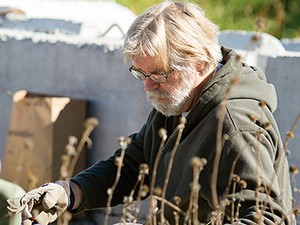
Utah State University students Margie Rycewicz-Borecki and Andrew Lewis prepare a soil sample at the bioretention site constructed for stormwater quality research. The team is working to determine if plants can play a more active role in remediating heavy metal buildup in stormwater retention areas.

Utah State University Professor Ryan Dupont clips vegetation from a test bay at a stormwater research site. Dupont is overseeing a research study that could unveil new information about low-cost phytoremediation. Images by Utah State University
In recent years, researchers and environmental engineering experts at Utah State University (USU) have looked closely at the level of pollutants carried by stormwater and how simple changes in stormwater management in cities and towns across Utah could help alleviate the problem. USU Department of Civil and Environmental Engineering researchers are wrapping up a long-term research study that could unveil valuable information about how vegetation can be used to more effectively remove heavy metals and other stormwater pollutants.
“The questions we originally asked were ‘how does stormwater quality change with the presence of vegetation?’ and ‘how much does it change?’” said Margie Rycewicz-Borecki, a USU doctoral candidate. “We’ve seen that vegetation does positively improve stormwater quality. We now ask ‘does the species of plant make a difference, and if so, how much?’”
Researchers constructed a test site on the outskirts of Logan City. Stormwater runoff from a nearby subdivision is collected and channeled into a retention site that is divided into 24 cells. The treatment cells were planted with one of three species commonly found in stormwater bioretention systems — cattail, sedge, and sunflower.
Rycewicz-Borecki is now examining whether the application of citric acid to the treatment cells stimulates the plants to take up more metals, thereby decreasing the buildup of metals in the soil.
Citric acid acts as a chelating agent, meaning it increases metal solubility and can improve metal uptake by plants. Unlike many widely studied synthetic chelators, such as EDTA, citric acid biodegrades quickly and does not persist in the environment, diminishing the potential for the chelated metals to leach into groundwater.
Prior to the citric acid study, sunflower was found to be effective at taking up zinc and copper, while sedges are effective at taking up phosphorus and nitrogen.
Professor and Advisor Ryan Dupont says the results will demonstrate that using this enhanced method of phytoextraction – where plants remove pollutants from the soil and water – can significantly increase heavy-metal uptake by plants. Afterward, the plants can be harvested and removed from the site.



